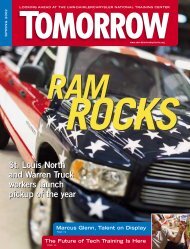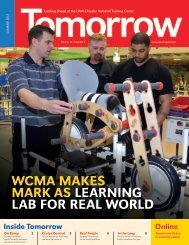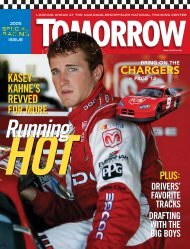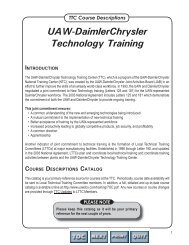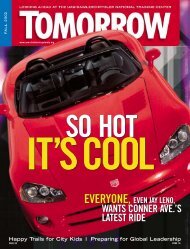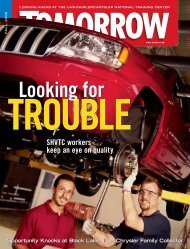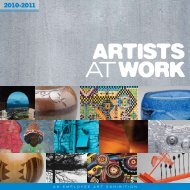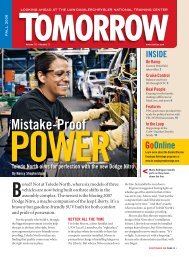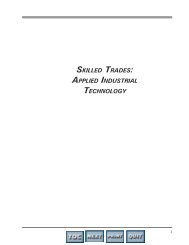Electrical Schematics (EST 100 ... - UAW-Chrysler.com
Electrical Schematics (EST 100 ... - UAW-Chrysler.com
Electrical Schematics (EST 100 ... - UAW-Chrysler.com
Create successful ePaper yourself
Turn your PDF publications into a flip-book with our unique Google optimized e-Paper software.
,1'8675,$/0$,17(1$1&(<br />
(/(&7521,&0$,17(1$1&(<br />
October 2003-September 2004<br />
&2856(,(7<br />
2 Hours<br />
&2856('(6&5,37,21<br />
The successful <strong>com</strong>pletion of this course should enable the participant to understand:<br />
1. fundamental concepts of electricity, including: voltage, grounds, AC voltage and frequency, and load;<br />
2. practical applications and calculations, including work with: meters, signed numbers, safety, current,<br />
resistance, color code, conductors and insulators, and wire size and type;<br />
3. units of measurement, including: prefixes, technicians triangle, head calculations, Ohms Law,<br />
power, voltage drops, safety, and ground faults;<br />
4. series and parallel circuits;<br />
5. voltage dividers, potentiometers, and rheostats;<br />
6. magnetic principles, including: magnetic fields, coils, transformers, and clamp-on meters;<br />
7. scopemeters and signal generators;<br />
8. power supply circuits, including: diodes, bridge rectifiers, capacitors, and filters;<br />
9. fundamental circuit parts, including: power connections, AC wiring, 3-phase (delta and<br />
wye), fuses and breakers, single-line diagrams, switches and relays, solenoids and contactors, and<br />
NEMA and IEC ratings;<br />
10. ladder diagramming, including: ladder symbols, low-voltage control, motor control centers,<br />
motor starters, thermal breakers, proximity switches, and indicator lights; and,<br />
11. AC motor drives including variable voltage, variable frequency, and pulse width modulation<br />
types of AC motor drives and applications.<br />
Week 1 Objectives:<br />
The participant will be able to work safely with electricity; use instruments to take and interpret electrical<br />
readings; read and interpret electrical drawings and ladder diagrams; identify and test electrical <strong>com</strong>ponents;<br />
and understand the basic principles of AC and DC Motors.<br />
Week 1 Topics Covered<br />
• Fundamental concepts • Practical applications • Units of measurement<br />
• Circuits • Components • Circuit parts<br />
• Ladder diagramming • AC motors • DC motors<br />
Week 2 Objectives<br />
The participant will be able to test equipment to identify which board needs to be replaced or repaired in an<br />
electronic system.<br />
Week 2 Topics Covered<br />
• Fundamental concepts • Circuits • Test equipment<br />
• Solid state switches • Op amps • Power supplies<br />
• Digital logic devices • Measurement techniques • Troubleshooting<br />
• Math review of relevant <strong>com</strong>putational techniques<br />
Þ&217,18('211(;73$*(Þ<br />
49




